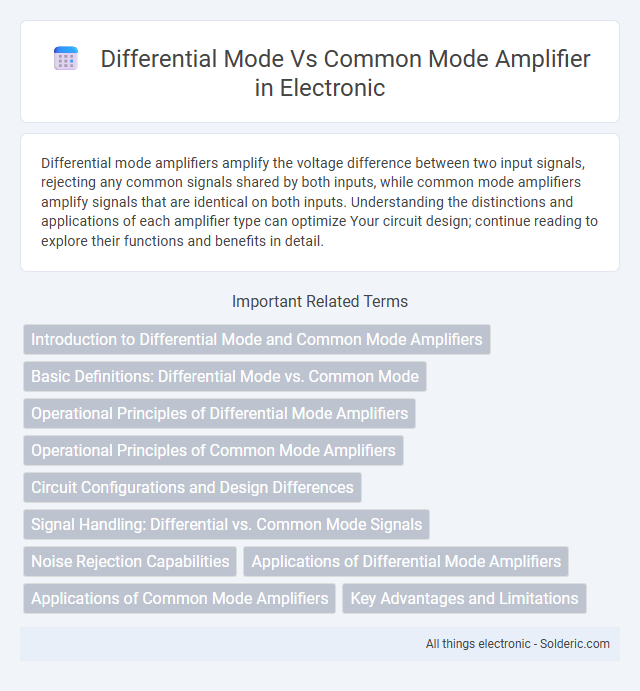Differential mode amplifiers amplify the voltage difference between two input signals, rejecting any common signals shared by both inputs, while common mode amplifiers amplify signals that are identical on both inputs. Understanding the distinctions and applications of each amplifier type can optimize Your circuit design; continue reading to explore their functions and benefits in detail.
Comparison Table
| Feature | Differential Mode Amplifier | Common Mode Amplifier |
|---|---|---|
| Signal Type | Amplifies difference between two input signals | Amplifies signals common to both inputs |
| Function | Rejects common noise, enhances differential signal | Amplifies common noise or interference |
| Gain | Differential Gain (Ad) | Common Mode Gain (Ac) |
| Use Case | Data acquisition, sensor signal conditioning | Common noise measurement, interference analysis |
| Design Goal | High Common Mode Rejection Ratio (CMRR) | Often minimized in circuits (not desired) |
| Output | Proportional to voltage difference (V1 - V2) | Proportional to voltage average ((V1 + V2)/2) |
Introduction to Differential Mode and Common Mode Amplifiers
Differential mode amplifiers amplify the voltage difference between two input signals, rejecting any signals common to both inputs, which enhances noise immunity and signal accuracy in applications such as sensor interfaces. Common mode amplifiers, in contrast, amplify signals that are present simultaneously and identically on both inputs, often used for noise detection or cancellation purposes. Understanding the operational principles and signal handling capabilities of both amplifier types is critical in designing circuits for precise analog signal processing and interference reduction.
Basic Definitions: Differential Mode vs. Common Mode
Differential mode refers to the operation where an amplifier processes the difference between two input signals, enhancing signal accuracy by rejecting noise common to both inputs. Common mode involves the amplifier responding to the identical signals present on both inputs simultaneously, often treated as unwanted interference to be minimized. Understanding this distinction helps optimize your amplifier design for improved signal integrity and noise suppression.
Operational Principles of Differential Mode Amplifiers
Differential mode amplifiers amplify the voltage difference between two input signals while rejecting any voltage common to both inputs, enhancing noise immunity and signal integrity. They operate by applying the input signals to the bases of a matched transistor pair or differential pair within an op-amp, producing an output proportional to the difference between these inputs. This fundamental principle makes differential mode amplifiers essential in applications requiring precise amplification of small differential signals in noisy environments.
Operational Principles of Common Mode Amplifiers
Common mode amplifiers operate by detecting and amplifying signals that are common to both input lines, effectively rejecting differential signals. Their operational principle relies on symmetrical input stages that balance the input signals, enhancing noise reduction and improving signal integrity. Understanding these principles allows you to design circuits with better interference suppression in environments prone to electromagnetic noise.
Circuit Configurations and Design Differences
Differential mode amplifiers utilize input signals applied between two terminals, amplifying the voltage difference while rejecting common signals, often implemented with precision matched transistor pairs or operational amplifiers in a differential pair configuration. Common mode amplifiers, designed to amplify signals common to both inputs, typically feature high common-mode gain and rely on circuit elements like resistors or current mirrors to maintain balance and stability. The design differences reflect in biasing schemes, transistor arrangements, and feedback networks aimed at optimizing differential gain versus common-mode rejection ratio (CMRR) for each amplifier type.
Signal Handling: Differential vs. Common Mode Signals
Differential mode amplifiers process the voltage difference between two input signals, effectively amplifying the intended signal while rejecting common mode noise present on both inputs. Common mode amplifiers amplify signals that are identical on both inputs, making them more susceptible to interference and less effective in noise rejection. The superior signal handling of differential mode amplifiers is essential in applications requiring high noise immunity and precise measurement of differential signals.
Noise Rejection Capabilities
Differential mode amplifiers exhibit superior noise rejection capabilities by amplifying the voltage difference between two input signals while suppressing any signals common to both inputs, known as common-mode noise. Common mode amplifiers, on the other hand, amplify signals present simultaneously and in-phase on both inputs, making them more susceptible to external electromagnetic interference and noise. The effectiveness of noise rejection in differential amplifiers is quantified by the Common Mode Rejection Ratio (CMRR), which is a critical parameter in ensuring high fidelity signal processing in noisy environments.
Applications of Differential Mode Amplifiers
Differential mode amplifiers are widely used in sensor signal conditioning, audio processing, and communication systems due to their ability to amplify the difference between two input signals while rejecting common noise and interference. They play a critical role in instrumentation amplifiers, ensuring high precision and stability in measurement systems such as ECG monitors and strain gauge amplifiers. These amplifiers also enhance signal integrity in balanced audio lines and differential data transmission, improving overall system performance in noisy environments.
Applications of Common Mode Amplifiers
Common mode amplifiers are extensively used in noise rejection applications such as sensor signal conditioning, data acquisition systems, and communication interfaces where eliminating interference from external noise is critical. These amplifiers enhance signal integrity by amplifying only the common voltage present on both inputs, making them essential in environments with high electromagnetic interference. Your circuits benefit from improved accuracy and reliability when integrating common mode amplifiers in differential signaling systems, medical instrumentation, and industrial automation.
Key Advantages and Limitations
Differential mode amplifiers excel in rejecting common-mode noise and interference, offering high signal integrity and improved noise immunity, which is essential in precision measurement systems. Common mode amplifiers provide simpler design and cost benefits but suffer from limited noise rejection and lower accuracy in amplifying differential signals. The choice depends on application requirements for noise rejection, signal fidelity, and complexity, with differential amplifiers favored for high-precision and noisy environments.
Differential mode vs Common mode amplifier Infographic

 solderic.com
solderic.com